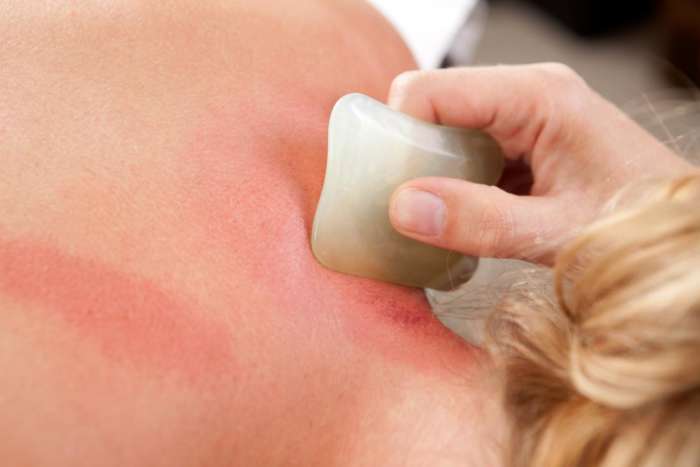
The first time you see the tools used to perform gua sha, you might wonder if this is more of a sadistic form of torture. But this ancient technique might be just what the doctor ordered for many different ailments.
Gua sha originated in ancient China. In fact, it’s one of the oldest forms of East Asian Medicine ever recorded, with historical records dating back to the Stone Age, according to China’s Ministry of Culture and Tourism. This folk remedy was often used to “scrape away illness,” and it was eventually written into major medical texts during the Ming Dynasty (1368 to 1644), per the ministry. In fact, the term gua sha translates to “scrape wind” and it uses a tool with a smooth edge to stroke or scrape skin in one direction. By scraping with repeated strokes on the surface of the skin, gua sha helps stimulate new blood flow and draw out stagnation in the problem areas to help generate metabolic cell repair and healing.
The “sha” (wind) or purple streaks that can appear on the surface during the process is thought to represent the severity of the stagnation of blood flow in the area. The stroking / scraping motions of gua sha, which are generally not painful, can cause capillaries near the skin surface to bleed, which causes the markings to surface. As strokes are applied, fluids and toxins are drawn to the skin.
Gua sha can be used for upper back, neck and shoulder pain, as well as a first aid go-to for chest colds and fevers. It can be used on almost any part of the body to loosen up scar tissue and release tight muscles. It can help with digestive issues, especially constipation and it can also be used on the head and face to relieve sinus pressure and TMJ pain. And there is even some evidence that gua sha on the scalp can stimulate the regrowth of hair.
Gua sha can be called by a couple of different names. The first is traditional. This is the East Asian Medicine technique in which a practitioner gently scrapes areas of your body with a smooth-edged tool. The aim, from a conventional medicine view, is to potentially reduce systemic inflammation, improve circulation, and / or increase range of motion.
Gua sha is also commonly referred to as the Graston Technique, especially by physical therapists. It’s similar to gua sha in that the practitioner scrapes the skin with a smooth-edged instrument, but the pressure tends to be a little heavier and more focused on the underlying tendons and fascia. This is used to encourage collagen production, while inhibiting pain.
Facial gua sha is a specialized practice that focuses on the face to relieve tension, puffiness, inflammation and sinus pressure. This practice also incorporates light cupping and acupuncture to achieve the desired results.
The marks that are left after a gua sha session may look shocking, but they are actually a good indicator that relief is happening. These marks are not bruises. This is sha and reflects the toxins which are being released from the body. The sha generally disappears within a few days and causes no damage.
Gua sha is frequently performed in homes in Asia and it is something that you can learn to do yourself, but it can be easier to let somebody else do the heavy lifting, especially on areas like the back. If you do intend to utilize gua sha at home, just make sure to learn the basics, either from an acupuncturist or an online course.

